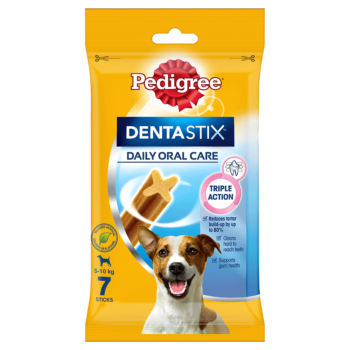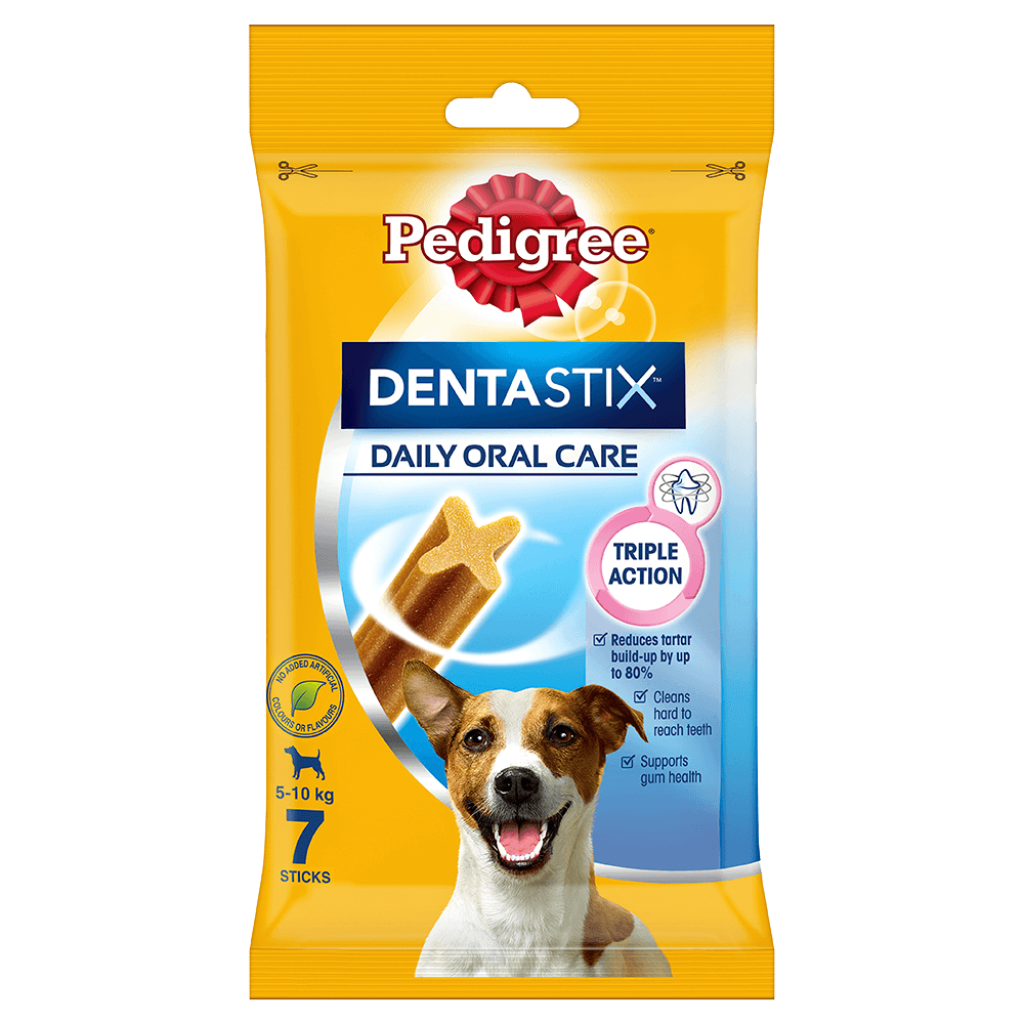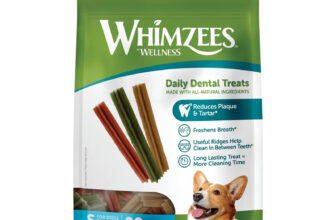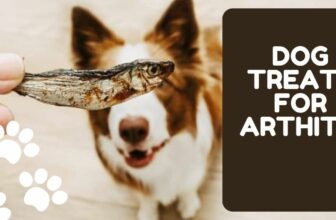Pedigree DentaStix Review

We all want our dog’s teeth to be healthy, which is the reason Pedigree Dentastix are one of the most popular dog “treats” in Australia.
But are they healthy, and have you wondered how they actually clean teeth?
Dental health is vital for the overall health of our pets, and we know how damaging dental disease can be. But are DentaStix the right option?
DentaStix review
What the marketing says
Pedigree has been a household name since before I was a kid, and I haven’t been a kid for quite some time. If you’ve read the review of Pedigree dog food then you’ll already know I won’t sing any praises for DentaStix as a healthy option for your dog – teeth OR health.
Pedigree is a Mars brand. The company most known for the chocolate bar which helps you work, rest, and play.
The DentaStix packet says these treats will “reduce tartar build-up by up to 80%”, claiming the unique “x-shape” and “abrasive texture” clean hard to reach teeth.
You have to laugh at claims which say “up to” whatever percent. Reducing tartar build up by 1% fits this statement, as does 0%.

But what about the ingredients?
Pedigree state the “active ingredients” are sodium tripolyphosphate & zinc sulphate. But do you know what those ingredients are? You may have to Google them…
None of the main ingredients are mentioned anywhere except small letters on the back of the packet.
Pedigree recommend you feed one DentaStix a day, which is great for them as you keep buying their products.
What the ingredients really say
Firstly, the ingredients in DentaStix are as follows:
Cereal; Humectant; Starch; Vegetable Gum; Minerals; Sodium Tripolyphosphate; Meat and Meat by-products (Pork); Vitamin E; Preservative; Zinc Sulphate; Flavours.
This is a food for a dog, right?
If I look at those big canine teeth in my dog’s mouth (combined with more in-depth knowledge of their dental and digestive system), I prefer to consider them a meat-eater. Don’t you?
As a qualified pet nutritionist I speak with some credibility when I say cereals, humectant, starch, and vegetable gum aren’t what I would choose to feed my meat-loving dog.
If these were ingredients in a “complete and balanced” dog food we’d been looking at 1 or 2 out of 10 tops, but dog treats don’t fall under the same regulations. Not that regulations for pet foods are much to rave about.
If you’re still thinking about stocking up on DentaStix, consider the following:
What humectants?
What starch?
Why don’t they say what these things really are?
The “active ingredient” sodium tripolyphosphate, or STPP, is commonly used as an emulsifier to keep foods moist. It’s a chemical which may have side-effects if consumed in excess, which is likely a reason Pedigree recommend only one a day (in the appropriate size for your dog).
Sodium tripolyphosphate can be found in some toothpastes (which we usually spit out rather than swallow). It may have some effect in removing stains, but also note it may negatively impact the enamel surface.
Zinc sulphate doesn’t have such a bad rep, and may go some way to control plaque, but note how insignificant it is in the ingredients. It’s right at the end of the ingredients list sandwiched between a completely ambiguous “preservative” and “flavours”.
Should you feed DentaStix to your dog?
Obviously it’s up to you, but keep in mind you’re feeding a treat made mostly of ingredients they don’t even want to tell you about.
Cereals and a load of other stuff you probably don’t want to feed your dog in excess. Ask yourself if those ingredients are good for dental health, or the health of your dog in general.
I definitely wouldn’t recommend feeding more than one a day, if you still want to feed them.
Where to buy DentaStix
If you must:
The real truth about dental treats?
Let’s talk about standards for pet treats in Australia.
Well, there really aren’t any. Even the standards for pet food are slack, with the option of an Australian pet food to fallback to the American AAFCO standard.
Treats by nature aren’t designed for health. They’re not designed to be fed in excess.
For a dental treat you could argue sticky toffee popcorn has an abrasiveness to it which may fight plaque. But don’t try it, and definitely don’t rely on it.
When it comes to dental treats you would assume they’re thoroughly backed by science, but this doesn’t need to be the case. Not at all.
Most treats are designed primarily for profit, and gimmicks such as saying they’re great for dental health are just that – gimmicks to make you buy.
What alternatives are there to DentaStix?
The other popular brand of dental treats is Greenies, but did you know both Greenies and DentaStix are both products of Mars?
Whimzees and OraVet are two other popular options in Australia. I dare you to find the meat amongst the potato starch and glycerin in Whimzees (because you won’t find any meat). I couldn’t even find the ingredients for OraVet, so they’ve done a good job at hiding those.
Related: Better treats for dogs, with health benefits.
So what is good for dental health?
Firstly, a good diet will always offer your dog better dental health. We know far too well sugars can rot our teeth, and most dog foods are high in carbs/sugars. Is yours?
Related: All dog food reviews.
Once you have a good diet in place, either brushing your dog’s teeth (if he lets you) or giving him things to chew on should really help him keep his teeth clean and tartar free.
Or what about a nice raw meaty bone?
How do you clean your dog’s teeth?







Hi.. I seen someone ask about OvaVet just now. This sent me on a mission (you know me lol).
I’ve just spent ages looking for the ingredients to no avail, only the active ingredient they rave on about (which isn’t something I’d expose myself of my dogs to).. Anyway, I found this site who have done a review..
https://www.hepper.com/oravet-dental-chew-review/
Interesting read… If these ARE the ingredients?!…
Despite this review, I wouldn’t recommend them
“If your pet suffers from gluten allergies or digestive issues, we recommend trying…”
Even if a dog isn’t showing signs of allergies, anything like this should be avoided as a preventive etc.
ANI
Dogs are not carnivores they are omnivorous.
If you consider a cat a carnivore (fact), and yourself as an omnivore (fact), would you consider your dog to be more similar to a cat or yourself? That’s probably the best way of considering it… I would consider “scavenging carnivore” or “facultative carnivore” to be more correct terms based on science and knowledge.